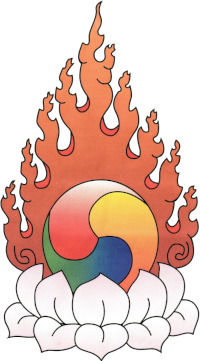LESSON SUMMARIES
(20:07) Lesson 26
Rimpoche further discusses taking refuge and karma, emphasizing that every action of ours makes a difference. He boils Buddhism down to the bus-stop speech: “Avoid negativities, build positivities, watch your mind.”
(25:33) Lesson 27
Nobody can hide from death. This awareness helps us to cultivate a mental state free of attachment to samsaric goodies; the perfect ground for dharma practice. Rimpoche describes the pain of rebirth, and then gives the visualization for taking refuge to protect against lower rebirth.
(11:56) Lesson 28
Buddha said karma is more difficult to understand than wisdom-emptiness. Karma is affected by the basis of motivation, so keep a fundamental basis of virtue. We carry a huge amount of negative and positive karma, so purification of transgressions is an important part of the seven limbed prayer. Comprehending karma, along with guru devotional practice, the importance of human life, impermanence, death, and rebirth, completes the “Common with the Lower Level” practice.
(22:16) Lesson 29
Guru devotional practice makes the struggle of spiritual practice easier and more uplifting. Brief “picnic spots” of pleasure keep us hooked in the misery of samsara, but we must build the mind of disliking samsara.
(15:46) Lesson 30
The “Common with the Medium Level” includes generating the desire for liberation, and the way to do so. Meditation is part of this, especially the type that makes our minds more active, rather than relaxed. There are many medical benefits known to come from the mental relaxation of meditation. But Buddha taught meditation for the Mahayana path that focuses on a subject, such as “as long as we have this attachment to samara, we will not be interested in liberation at all because attachment will hold us back.”
(13:27) Lesson 31
Rimpoche describes visualizations associated with meditation on renouncing samsara, and the request to Lama Tubwang Dorje Chang, giving the blessing to develop the “Common with Medium Level”.
(17:54) Lesson 32
Our samsara is actually the contaminated continuation of identity. Rimpoche describes how this continuation, through reincarnation, is very subtle. Renouncing samsara is renouncing this contaminated continuation.
(19:11) Lesson 33
Buddha gave the Three Basket Trainings, which are the three higher trainings of morality, sutra, and metaphysics (or morality, wisdom, and concentration). These are the way to liberation.
(17:04) Lesson 34
Rimpoche defines the mental state of bodhimind and defines a bodhisattva as someone who has this mental state, which is ultimate, unlimited, unconditional compassion and love. One way to develop bodhimind is through the seven stages of development.
(15:47) Lesson 35
Compassion can be limited and conditional: we pay more attention if the suffering person is someone close to us. Conditional compassion results from attachment-oriented thinking. Bodhimind grows out of a commitment to liberate all sentient beings.
(17:07) Lesson 36
Bodhimind involves a genuine, naturally-arising commitment. That can only happen with greater compassion. Greater compassion requires ultimate love. Love is born from appreciation and gratitude. Buddha tells us to look to all living beings as mother sentient beings, to whom we are grateful for their gift of life, nurturing, and saving our lives. A key part is the desire to seek buddhahood oneself, in order to have the best tool to help others.
(16:55) Lesson 37
Rimpoche describes the details of the visualization for meditation on the seven stages of development, starting with Lama Buddha Vajradhara in the space before me, and ending with yourself as Buddha, sending out five-colored nectar to all living beings, giving them the temporary benefit of a wonderful life, and the permanent benefit of ultimate liberation.
(21:41) Lesson 38
The goal and struggle of the spiritual path is the purification of our contaminated identities. Our identities are impermanent, so these good changes are possible. Even with some mistakes, we usually don’t fall back from our positive changes, which shows that the spiritual path is right.
(19:46) Lesson 39
Our simple basis for judging right and wrong is whether things are helpful or hurtful. This includes not hurting ourselves; Buddha taught non-violence and was against harming oneself. Even rules for celibate disciples had many exceptions for individuals with special needs. Rimpoche also cautions against power struggles, black magic, and engaging with crazy people.
(20:56) Lesson 40
Drawing the line between right and wrong by what helps and what hurts living beings is in accordance with how karma works. Samsara makes people think that they must hurt others in order to protect themselves or others, which is how most wars are justified. Renounce this thinking, set it as our target for change, not for destruction. Spiritual practitioners don’t destroy their target, they transform it
.
(23:29) Lesson 41
One quality of the Lamrim for the individual is to bring all teachings of the Buddha together. Theravada, Mahayana, and Vajrayana teachings all have equal importance. A bodhisattva might have the motivation to help, but without Theravada practice, they would not have the experience and qualification to help. Recognizing and repaying kindness is good, normal, respectable behavior.
(22:45) Lesson 42
Rimpoche describes the development of bodhimind through the practice of exchanging self and others. This practice helps us to decrease our self-cherishing by collecting the sufferings of others onto ourselves, and giving our virtues and merit to others. Developing bodhimind through exchanging self and others corresponds with many practices, including the Lama Chöpa.
(14:57) Lesson 43
Developing bodhimind through ritual involves taking the bodhisattva vows. There is a ceremonial component and a commitment component. The ritual ceremony utilizes all the senses to move one’s consciousness and draw emotional attention. One joins the family of the buddhas by taking the bodhisattva commitment.
(19:37) Lesson 44
Bodhimind must be maintained continuously. Avoid the four dark activities, and the root and secondary downfalls. Rimpoche answers some audience questions about the nature of Vajrayana vows, and their persistence even after death.
(16:44) Lesson 45
There are many paths to delivering the ultimate spiritual development to the individual. Rimpoche lists the divisions within Tibetan Buddhism, and Buddhism in general, explaining that a great yogi will see Lamrim and Delam as the real essence of Buddha’s teaching of the Prajna Paramita (Transcendental Wisdom Sutra).
(16:21) Lesson 46
Rimpoche reviews guru devotional practice, emphasizing that effort, meditation and practice are needed to truly learn. Training the mind is next, and the importance of life. Rimpoche summarizes the first two layers of the actual practice.
(15:43) Lesson 47
The Three Higher Trainings (Tripitaka) allow us to safeguard the future through morality, and transform the identity through concentration and wisdom. Rimpoche gives a rare glimpse into the evolution of his own recent spiritual practice (including the Guhyasamaja Sadhana), and how long it takes. Practice transforms our character, making bodhimind become part of our lives, making all of our actions beneficial.
(11:23) Lesson 48
We are physically, mentally, and emotionally involved in the melodrama of samsara… but not really. If we don’t move along with this melodrama of life, we become crazy. But if we completely fall into it, we become stupid. Bodhimind development completes the third layer, after the lower and medium scopes.
(25:21) Lesson 49
After developing bodhimind, Delam includes a meditation on the Six Perfections.
Rimpoche succinctly describes the six paramitas: Generosity, morality, patience, enthusiasm, concentration, and wisdom.
(10:53) Lesson 50
Except for a few more details on concentration and wisdom, this completes the Delam teaching, which is the three scopes and the six paramitas. Rimpoche gives acknowledgements to his hosts, and urges all of us to retain and digest as much as we can.


